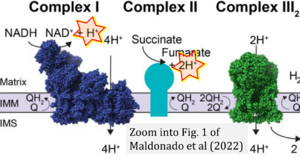Maldonado 2022 Int J Mol Sci
| Maldonado M, Abe KM, Letts JA (2022) A structural perspective on the RNA editing of plant respiratory Complexes. Int J Mol Sci 23:684. https://doi.org/10.3390/ijms23020684 |
Maldonado M, Abe KM, Letts JA (2022) Int J Mol Sci
Abstract: The last steps of respiration, a core energy-harvesting process, are carried out by a chain of multi-subunit complexes in the inner mitochondrial membrane. Several essential subunits of the respiratory complexes are RNA-edited in plants, frequently leading to changes in the encoded amino acids. While the impact of RNA editing is clear at the sequence and phenotypic levels, the underlying biochemical explanations for these effects have remained obscure. Here, we used the structures of plant respiratory complex I, complex III2 and complex IV to analyze the impact of the amino acid changes of RNA editing in terms of their location and biochemical features. Through specific examples, we demonstrate how the structural information can explain the phenotypes of RNA-editing mutants. This work shows how the structural perspective can bridge the gap between sequence and phenotype and provides a framework for the continued analysis of RNA-editing mutants in plant mitochondria and, by extension, in chloroplasts.
• Bioblast editor: Gnaiger E
Hydrogen ion ambiguities in the electron transfer system
Communicated by Gnaiger E (2023-10-08) last update 2023-11-10
- Electron (e-) transfer linked to hydrogen ion (hydron; H+) transfer is a fundamental concept in the field of bioenergetics, critical for understanding redox-coupled energy transformations.
- However, the current literature contains inconsistencies regarding H+ formation on the negative side of bioenergetic membranes, such as the matrix side of the mitochondrial inner membrane, when NADH is oxidized during oxidative phosphorylation (OXPHOS). Ambiguities arise when examining the oxidation of NADH by respiratory Complex I or succinate by Complex II.
- Oxidation of NADH or succinate involves a two-electron transfer of 2{H++e-} to FMN or FAD, respectively. Figures indicating a single electron e- transferred from NADH or succinate lack accuracy.
- The oxidized NAD+ is distinguished from NAD indicating nicotinamide adenine dinucleotide independent of oxidation state.
- NADH + H+ → NAD+ +2{H++e-} is the oxidation half-reaction in this H+-linked electron transfer represented as 2{H++e-} (Gnaiger 2023). Putative H+ formation shown as NADH → NAD+ + H+ conflicts with chemiosmotic coupling stoichiometries between H+ translocation across the coupling membrane and electron transfer to oxygen. Ensuring clarity in this complex field is imperative to tackle the apparent ambiguity crisis and prevent confusion, particularly in light of the increasing number of interdisciplinary publications on bioenergetics concerning diagnostic and clinical applications of OXPHOS analysis.



